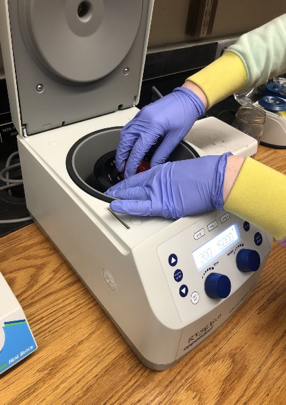4/7/21
Abby Mueller and Marley Fuhrman
Introduction:
In our previous blog post the last procedure we did consisted of ligating our gene with the plasmid. Since then, we performed a transformation procedure and then grew the bacteria. We have seen bacteria growth, which is a good sign as we move forward.
Specific Content:
After we finished the ligation process, we did a transformation procedure in E. coli to fuse our gene with the plasmids that we have been working with. We then used LB broth as a growth medium forour transformed E. coli, and we spread these bacteria onto agar plates. To get bacteria colonies with our gene ligated to the E. coli plasmid, the agar plates contained ampicillin which would kill any E. coli cells that did not contain the plasmid. After 24 hours of incubation, we revisited our plates and saw that a total of 8 colonies had grown on the two plates. Since we needed at least 10 colonies to do the patching process, we decided to spread the leftover of our transformed E. coli on 2 more agar plates and incubate them for a day to grow more colonies.
The second round of plates came back with much better results than the first couple, with each having over 20 colonies. So we each picked 10 colonies from our plates and patched them onto an agar plate with numbered sections, with one colony getting patched into each section. We did this to further isolate the colonies and create a bigger surface area for them to grow so they would be easier to harvest later. We incubated the new patched plates for 24 hours and results can be seen in the attached image (Figure 2).
Next, we scraped 1/4th of the cells from 5 of the best colonies on each of our plates and suspended them in water in a tube so we could boil them. The purpose of boiling them was to break the cells and release the plasmid DNA that contained our gene. We only boiled them for 7 minutes before they were cooled then put on ice. We then used the DNA plasmids that were released from the previous step as the templates and created a PCR for each different E. coli streak, plus a positive control that contained genomic DNA of Flavobacterium psycrophylum.
Reflection:
These past few weeks have yielded positive results. We have seen a lot of bacteria growth and we expect to see positive results on the colony PCR gel we will run this week. Once we have successful plasmids for the downstream region, we will move on to cloning the upstream region of our target gene and perform the same process of E. coli plasmid extraction, DNA digestion, ligation, and transformation.



